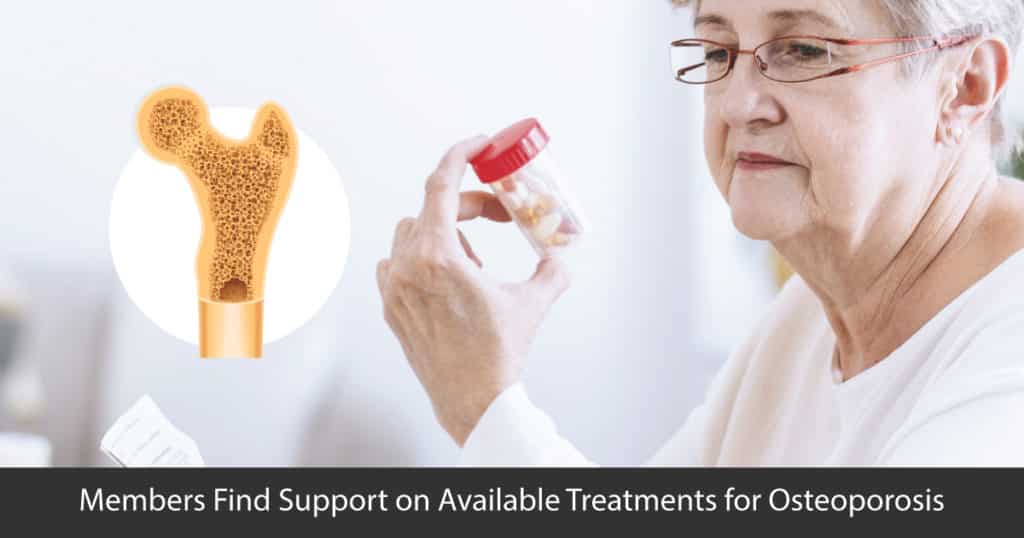Members Find Support on Available Treatments for Osteoporosis

While the CDC is urging the public and the medical community to delay “all elective and ambulatory provider visits,” Inspire’s partner, the National Osteoporosis Foundation (NOF), is stressing the need for osteoporosis patients to adhere to their medication schedule, including medications that require provider administration. “It is extremely important that patients taking… (anti-osteoporosis) medications administered by a healthcare provider stay on time for scheduled injections.”1 They then list several common medications that fall into this category. This complicates an already challenging condition for the over 254,000 unique osteoporosis patients (users) per year that visit the National Osteoporosis Foundation Support Community on Inspire.
Osteoporosis is a common affliction with serious consequences for the mobility and independence of millions of older people, among others. The NOF website states that:
About 54 million Americans have osteoporosis and low bone mass, placing them at increased risk for osteoporosis. Studies suggest that approximately one in two women and up to one in four men age 50 and older will break a bone due to osteoporosis… twenty percent of seniors who break a hip die within one year from either complications related to the broken bone itself or the surgery to repair it.1
Unfortunately, most people prescribed anti-osteoporosis drugs fail to stay on their medication long-term. A 2015 study of 344 osteoporosis patients taking oral medication found that “Osteoporosis treatment has low adherence and persistence,”3 particularly for those on daily medications. The patients with the greatest medication adherence by far were those taking spaced doses: “[W]eekly administration had a >5-fold higher adherence and monthly administration an 8-fold higher adherence (p < 0.0001) than daily administration.” The same study concluded that, “costly interventions such as phone calls and educational meetings, did not provide significant advantages.”2
Furthermore, a 2016 study in the UK found that two of the reasons for lack of adherence on osteoporosis medications were “poor patients’ awareness and sub-optimal physicians’ involvement in conveying the importance of this therapy.”3
For those with chronic conditions, turning to peers online for medication advice and experiences — including what to do when your treatment is supposed to take place in a shutdown — isn’t new. Questions like, “Has anyone tried [drug name]?” are frequent. In this case, part of the above 17 responses in this discussion dealt with a limitation on the length of time one can stay on this medication and requests for guidance as to what drugs to consider afterwards.
In another case a member expressed resistance to a particular medication that had been prescribed, wanting instead to use supplements to deal with their condition. “Do not want to start [drug name]” Of the 43 replies, 24 were very positive about the drug and urged the writer to consider it; two more respondents still recommended the medication, even after experiencing some side effects. One responder said, “I just finished my 2 year prescription of [drug name] last month. I no longer have osteoporosis. I had absolutely no problems with this drug—-no side effects at all. I highly recommend [drug name]”.
Another member worried about the side effects of certain medications. In the 13 replies, members reassured the member that they had experienced negligible side effects and remarked that fractures were far worse than any side effect.
Finally, in response to a question on rebuilding bone density, one member provided links to articles that explained the actions of two different drugs. After reading these links, a third member decided,“I see my doctor again in April and right now I feel this is the treatment option I am most comfortable with.”
Clearly, patients openly discuss their treatment experiences on Inspire. Our 4th annual survey of Inspire’s 2 million+ members showed that 81% of respondents look for disease-specific information online and in blogs, with 53% seeking it within online communities. Inspire’s osteoporosis community of an engaged patients and caregivers are eager to learn about treatment options.
Inspire offers a trusted community to patients and caregivers. Our goal with this blog, this website and our content is to provide the life science industry access to the true, authentic patient voice. In so doing, we support faithful operationalization of patient-centricity. Take a look at our case studies, eBooks and news outlet coverage.
References
1 https://www.nof.org/covid-19-updates/
2https://pubmed.ncbi.nlm.nih.gov/25619634/
3Clark, EM et al. “Natural History, Reasons For, and Impact of Low/Non-Adherence to Medications for Osteoporosis in a Cohort of Community-Dwelling Older Women Already Established on Medication: A 2-year Follow-Up Study.” DOI: 10.1007/s00198-015-3271-2 https://pubmed.ncbi.nlm.nih.gov/26286625/






